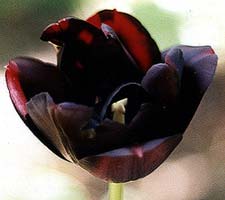 'Queen of Night' Tulip
'Queen of Night' Tulip
"Men plant tulips upon dunghills
when they wish them finest."
-Elizabeth Barrett Browning
We have planted almost exclusively botanical tulips, but a few large hybrids pop up here & there even years after they were planted. Hybrids don't naturalize as well as botanicals, so the hybrids are of uneven quality over time. Even so, the few Triumph Tulips that persist we make no attempt to dig out or discard, as they're interesting even if minor; & when we were given a freebie Apeldoorn Darwin tulip we figured what the heck, & planted it.
When these old bulbs have been in the way of something important, I have occasionally dug them out, whether to discard or replant out of the way. It is sometimes shocking how deep in the ground they are buried! Certainly no gardeners ever planted them so deeply. Some tulips have retracting roots that literally pull the bulb a little further down each year.
Among the "ordinary" hybrid tulips that pop up here & there in the garden, one that is quite likeable is 'Queen of Night' which would make a fine choice for a "Gothic Garden." Its nearly black flower is shown in an April 2002 photo above. It is a deep chocolate-purple that purports to be one of the blackest of tulips, & some of them in the right light do look very black. The variety has probably been in peoples' gardens since the 1920s, but was only given its name in 1944.
The elusive quest for a true black tulip remained for decades no better found than in 'Queen of Night.' Indeed growers have been striving to develop a true black tulip for centuries without quite achieving it.
The unachieved Black Tulip became a symbol, akin to that of the Blue Rose, of high Romantism. If the poet's dream of the Blue Rose was the Romanticist ideal of unachievable perfect beauty, the Black Tulip was the symbol of deep dark cruelties, as it indeed symbolized for Alexander Dumas in his novelette The Black Tulip (1850), a sensationalist tale of greed, torture, murder, & the unwholesome desire of tulip growers to obtain the titular flower.
For decades 'Queen of Night' stood as the closest that existed to the ideal. Some have said the 1984 sport of 'Queen of Night,' dubbed 'Black Hero,' is a step closer, but really it is a step closer to brown & 'Queen of Night' is a better color. 'Black Hero' however has more petals. The coolest of the fake blacks is 'Black Parrot,' developed in 1934. It's a very frilly tulip which, while hardly black at all, is such a macabre bloody red-black as to seriously fulfil the gothic intent.
If I were selecting an allegedly "black" tulip right now, it would probably be 'Black Parrot' instead of 'Queen of Night.' But we're not terribly likely to have any of the other "black" tulips because we've largely turned out backs on hybrids, & have become much more seriously enamored of little species tulips.